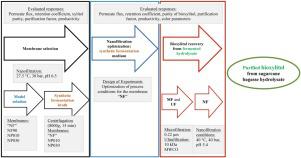当前位置:
X-MOL 学术
›
Food Bioprod. Process.
›
论文详情
Our official English website, www.x-mol.net, welcomes your
feedback! (Note: you will need to create a separate account there.)
From by- to bioproducts: selection of a nanofiltration membrane for biotechnological xylitol purification and process optimization
Food and Bioproducts Processing ( IF 3.5 ) Pub Date : 2021-01-01 , DOI: 10.1016/j.fbp.2020.10.005 Yara Pereira Cerceau Alves , Felipe Antonio Fernandes Antunes , Silvio Silverio da Silva , Marcus Bruno Soares Forte
Food and Bioproducts Processing ( IF 3.5 ) Pub Date : 2021-01-01 , DOI: 10.1016/j.fbp.2020.10.005 Yara Pereira Cerceau Alves , Felipe Antonio Fernandes Antunes , Silvio Silverio da Silva , Marcus Bruno Soares Forte

|
Abstract Xylitol, an alcohol sugar with diverse applications, is commonly synthesized by chemical routes on an industrial scale. This polyalcohol can also be obtained by fermentation of lignocellulosic biomass. However, downstream purification is still a bottleneck that increases the costs and limits the yield of bioxylitol production. This study aimed to develop a novel approach for purification of xylitol obtained by fermentation of sugarcane bagasse hemicellulose hydrolysate. After nanofiltration membrane selection, process conditions were optimized by surface response methodology. Four nanofiltration membranes were tested: NF (polypiperazine amide), NF90 (fully aromatic polyamide), and NP010 and NP030 (polyethersulfones). NF had the lowest fouling tendency and provided the highest xylitol–protein separation factor and feed–permeate color difference. Factorial design studies revealed that permeate flux and color parameter a* were significantly influenced by pH and pressure. Xylitol productivity and lightness difference were affected by temperature. The best nanofiltration conditions were 40 bar, 40 °C, and pH 5.4. Fermented hydrolysate was subjected to microfiltration and ultrafiltration prior to nanofiltration to minimize fouling. Results were satisfactory, with a xylitol purification factor of 3.3, protein separation factor of 8.4, and color removal of 96.0%. Nanofiltration can be used as a preceding step to crystallization in the purification of xylitol obtained from sugarcane bagasse hydrolysate.
中文翻译:

从副产品到生物产品:选择用于生物技术木糖醇纯化和工艺优化的纳滤膜
摘要 木糖醇是一种用途广泛的醇糖,通常通过工业规模的化学途径合成。这种多元醇也可以通过木质纤维素生物质的发酵获得。然而,下游纯化仍然是一个瓶颈,增加了成本并限制了生物木糖醇生产的产量。本研究旨在开发一种纯化甘蔗渣半纤维素水解物发酵获得的木糖醇的新方法。选择纳滤膜后,通过表面响应法优化工艺条件。测试了四种纳滤膜:NF(聚哌嗪酰胺)、NF90(全芳香聚酰胺)以及 NP010 和 NP030(聚醚砜)。NF 的结垢倾向最低,并提供最高的木糖醇-蛋白质分离因子和饲料-渗透物颜色差异。因子设计研究表明,渗透通量和颜色参数 a* 受 pH 值和压力的显着影响。木糖醇生产率和亮度差异受温度影响。最佳纳滤条件为 40 bar、40 °C 和 pH 5.4。发酵水解物在纳滤之前经过微滤和超滤,以尽量减少结垢。结果令人满意,木糖醇纯化系数为 3.3,蛋白质分离系数为 8.4,颜色去除率为 96.0%。在从甘蔗渣水解产物中获得的木糖醇的纯化中,纳滤可用作结晶的前一步。因子设计研究表明,渗透通量和颜色参数 a* 受 pH 值和压力的显着影响。木糖醇生产率和亮度差异受温度影响。最佳纳滤条件为 40 bar、40 °C 和 pH 5.4。发酵水解物在纳滤之前经过微滤和超滤,以尽量减少结垢。结果令人满意,木糖醇纯化系数为 3.3,蛋白质分离系数为 8.4,颜色去除率为 96.0%。在从甘蔗渣水解产物中获得的木糖醇的纯化中,纳滤可用作结晶的前一步。因子设计研究表明,渗透通量和颜色参数 a* 受 pH 值和压力的显着影响。木糖醇生产率和亮度差异受温度影响。最佳纳滤条件为 40 bar、40 °C 和 pH 5.4。发酵水解物在纳滤之前经过微滤和超滤,以尽量减少结垢。结果令人满意,木糖醇纯化系数为 3.3,蛋白质分离系数为 8.4,颜色去除率为 96.0%。在从甘蔗渣水解产物中获得的木糖醇的纯化中,纳滤可用作结晶的前一步。和 pH 值 5.4。发酵水解物在纳滤之前经过微滤和超滤,以尽量减少结垢。结果令人满意,木糖醇纯化系数为 3.3,蛋白质分离系数为 8.4,颜色去除率为 96.0%。在从甘蔗渣水解产物中获得的木糖醇的纯化中,纳滤可用作结晶的前一步。和 pH 值 5.4。发酵水解物在纳滤之前经过微滤和超滤,以尽量减少结垢。结果令人满意,木糖醇纯化系数为 3.3,蛋白质分离系数为 8.4,颜色去除率为 96.0%。在从甘蔗渣水解产物中获得的木糖醇的纯化中,纳滤可用作结晶的前一步。
更新日期:2021-01-01
中文翻译:

从副产品到生物产品:选择用于生物技术木糖醇纯化和工艺优化的纳滤膜
摘要 木糖醇是一种用途广泛的醇糖,通常通过工业规模的化学途径合成。这种多元醇也可以通过木质纤维素生物质的发酵获得。然而,下游纯化仍然是一个瓶颈,增加了成本并限制了生物木糖醇生产的产量。本研究旨在开发一种纯化甘蔗渣半纤维素水解物发酵获得的木糖醇的新方法。选择纳滤膜后,通过表面响应法优化工艺条件。测试了四种纳滤膜:NF(聚哌嗪酰胺)、NF90(全芳香聚酰胺)以及 NP010 和 NP030(聚醚砜)。NF 的结垢倾向最低,并提供最高的木糖醇-蛋白质分离因子和饲料-渗透物颜色差异。因子设计研究表明,渗透通量和颜色参数 a* 受 pH 值和压力的显着影响。木糖醇生产率和亮度差异受温度影响。最佳纳滤条件为 40 bar、40 °C 和 pH 5.4。发酵水解物在纳滤之前经过微滤和超滤,以尽量减少结垢。结果令人满意,木糖醇纯化系数为 3.3,蛋白质分离系数为 8.4,颜色去除率为 96.0%。在从甘蔗渣水解产物中获得的木糖醇的纯化中,纳滤可用作结晶的前一步。因子设计研究表明,渗透通量和颜色参数 a* 受 pH 值和压力的显着影响。木糖醇生产率和亮度差异受温度影响。最佳纳滤条件为 40 bar、40 °C 和 pH 5.4。发酵水解物在纳滤之前经过微滤和超滤,以尽量减少结垢。结果令人满意,木糖醇纯化系数为 3.3,蛋白质分离系数为 8.4,颜色去除率为 96.0%。在从甘蔗渣水解产物中获得的木糖醇的纯化中,纳滤可用作结晶的前一步。因子设计研究表明,渗透通量和颜色参数 a* 受 pH 值和压力的显着影响。木糖醇生产率和亮度差异受温度影响。最佳纳滤条件为 40 bar、40 °C 和 pH 5.4。发酵水解物在纳滤之前经过微滤和超滤,以尽量减少结垢。结果令人满意,木糖醇纯化系数为 3.3,蛋白质分离系数为 8.4,颜色去除率为 96.0%。在从甘蔗渣水解产物中获得的木糖醇的纯化中,纳滤可用作结晶的前一步。和 pH 值 5.4。发酵水解物在纳滤之前经过微滤和超滤,以尽量减少结垢。结果令人满意,木糖醇纯化系数为 3.3,蛋白质分离系数为 8.4,颜色去除率为 96.0%。在从甘蔗渣水解产物中获得的木糖醇的纯化中,纳滤可用作结晶的前一步。和 pH 值 5.4。发酵水解物在纳滤之前经过微滤和超滤,以尽量减少结垢。结果令人满意,木糖醇纯化系数为 3.3,蛋白质分离系数为 8.4,颜色去除率为 96.0%。在从甘蔗渣水解产物中获得的木糖醇的纯化中,纳滤可用作结晶的前一步。










































 京公网安备 11010802027423号
京公网安备 11010802027423号